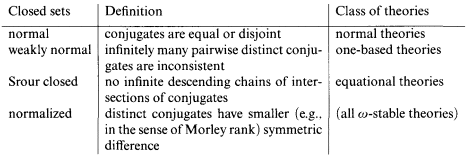Article contents
A note on equational theories
Published online by Cambridge University Press: 12 March 2014
Extract
Several attempts have been done to distinguish “positive” information in an arbitrary first order theory, i.e., to find a well behaved class of closed sets among the definable sets. In many cases, a definable set is said to be closed if its conjugates are sufficiently distinct from each other. Each such definition yields a class of theories, namely those where all definable sets are constructible, i.e., boolean combinations of closed sets. Here are some examples, ordered by strength:

Weak normality describes a rather small class of theories which are well understood by now (see, for example, [P]). On the other hand, normalization is so weak that all theories, in a suitable context, are normalizable (see [HH]). Thus equational theories form an interesting intermediate class of theories. Little work has been done so far. The original work of Srour [S1, S2, S3] adopts a point of view that is closer to universal algebra than to stability theory. The fundamental definitions and model theoretic properties can be found in [PS], though some easy observations are missing there. Hrushovski's example of a stable non-equational theory, the first and only one so far, is described in the unfortunately unpublished manuscript [HS]. In fact, it is an expansion of the free pseudospace constructed independently by Baudisch and Pillay in [BP] as an example of a strictly 2-ample theory. Strong equationality, defined in [Hr], is also investigated in [HS].
Information
- Type
- Research Article
- Information
- Copyright
- Copyright © Association for Symbolic Logic 2000
References
REFERENCES
- 3
- Cited by

